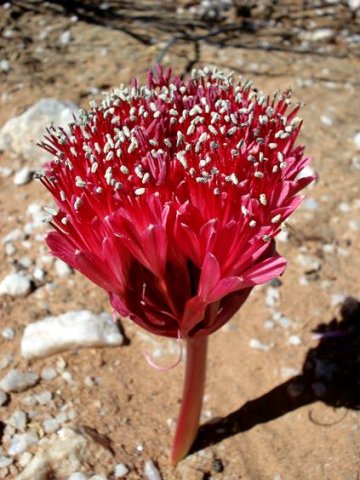Brunsvigia

Author: Ivan Lätti
Photographer: Judd Kirkel Welwitch
Brunsvigia is a genus of deciduous, bulbous perennials in the Amaryllidaceae family. The plants are either winter- or summer-growing, from 60 cm to 1,2 m tall when in flower.
The subterranean or partially exposed bulbs vary between 2 cm and 20 cm in diameter. The outer tunics of the bulbs are cartilaginous or parchment-like, the fibres extensible when torn and the tunic in many cases produced into a thick neck. The perennial roots are fleshy.
From two to twenty leaves, usually from four to six, are grown during or after flowering. The leaves are positioned flat on the ground or sub-erect to erect, sometimes distichous in opposite arrays or fan-shaped. Leaf-shapes vary from tongue-shaped, spoon-shaped, strap-shaped or oblong to sickle-shaped. The surfaces are sometimes leathery, smooth or papillary, (the latter mainly below) and the margins raised or fringed, sometimes with branched hairs.
The inflorescences bear from 2 to 80 flowers, sometimes in hemispherical heads. The scapes are solid and compressed, from 3 cm to 60 cm long and breaking free at ground level when the fruits are ripe. There is a two-valved, variously coloured spathe, leathery or papery in texture that initially covers the buds clustered at the top of the spathe.
The flower-shape is irregular to nearly regular, i.e., variably zygomorphic and flared or funnel-shaped. Perianths are coloured pink or red, rarely white. The flower pedicels radiate from the peduncle tip and usually elongate during fruiting. The tepals are together at the base in a short tube or free, the segments varying in width. They are oblong to lanceolate in shape, sometimes recurving; some bearing dark veins, others mono-coloured.
Six almost equal stamens arise from near the tepal bases. Their filaments are thread-like, sometimes clustered at the base, the anthers variably exserted. The three-locular ovary is inferior, nearly spherical to conical, bearing three to ten ovules per locule. The thread-like style ends in three, usually small stigma lobes. Most plants are pollinated by diurnal insects, a few by moths.
The inflated fruit capsule, varying in size, is spindle-shaped, tapering to both ends or triangular, three-ribbed with transverse veining. The seeds are fleshy and ovoid or globose, usually reddish green or brown, housed in dry capsules. The severed fruitheads are blown by the wind, aerial or rolling, effective in seed dispersal.
There are 18 species of Brunsvigia occurring widespread in southern Africa, many of them found in the semi-arid regions. The plant in picture is Brunsvigia pulchra (Duncan, et al, 2016; Leistner, (Ed.), 2000; http://pza.sanbi.org).

